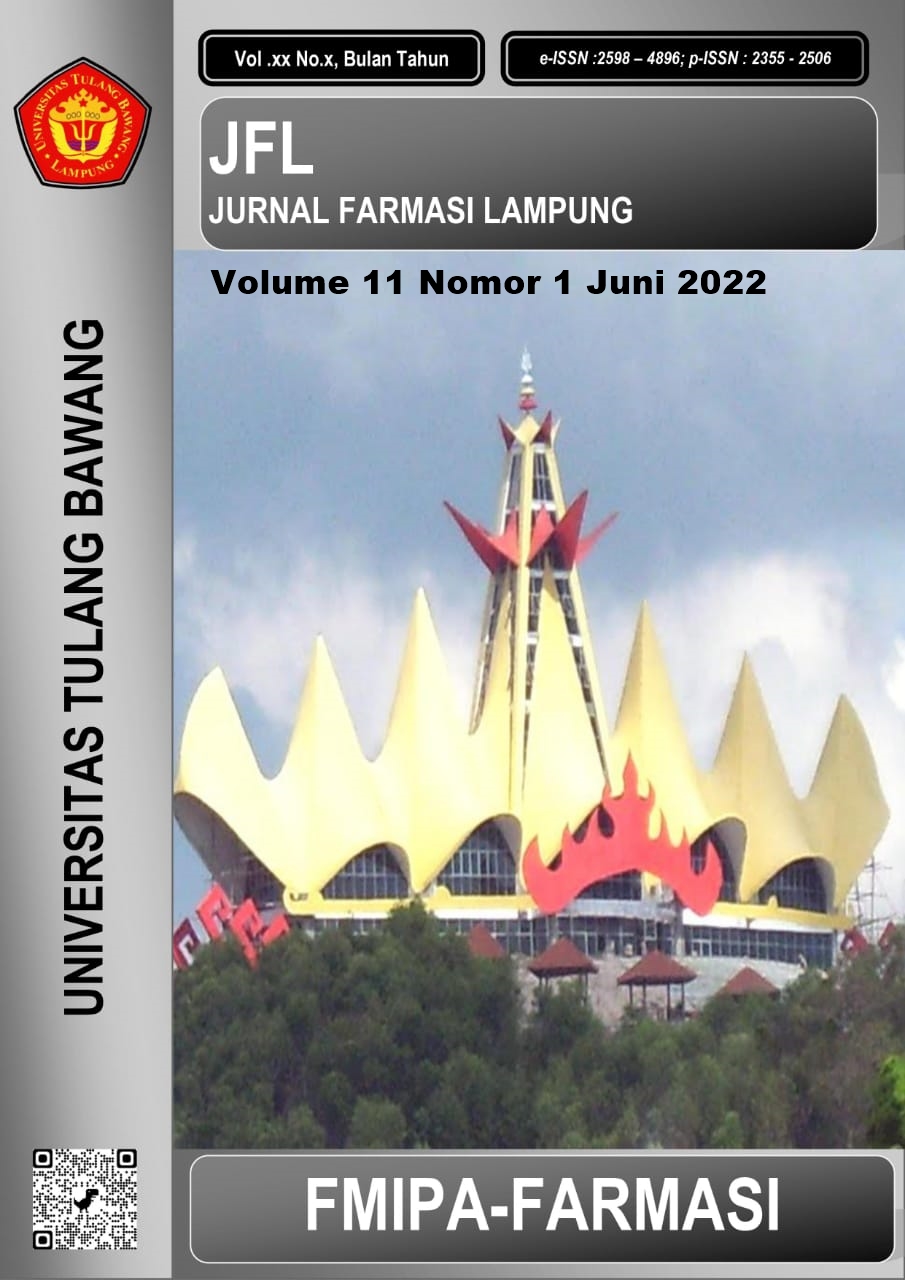UJI DAYA HAMBAT ANTIBAKTERI KOMBINASI EKSTRAK DAUN PEPAYA ( Carica papaya L. ) DENGAN DAUN SIRIH ( Piper betle L. ) TERHADAP BAKTERI Staphylococcus aureus
DOI:
https://doi.org/10.37090/jfl.v11i1.714Abstract
Infection is a disease that is often found in Indonesia. Infectious diseases can be caused by one of the gram-positive bacteria, staphylococcus aureus bacteria. How to prevent infectious diseases is to inhibit the growth of Staphylococcus aureus bacteria. Papaya leaf plant (Carica papaya L.) and betel leaf plant (Piper betle L.) is a plant that has long been used by the community as a traditional medicine that can cure diseases, one of which is as an antibacterial. This study aims to find out the antibacterial bland power of the combination of papaya leaf extract with betel leaves in inhibiting Staphylococcus aureus bacteria. The method used is an experimental method of combining the concentration of papaya leaf extract with betel leaves, namely K1 (100%+0%), K2 (30%+70%), K3 (40%+60%), K4 (50%+50%), K5 (60%+40%), K6 (70%+30%), K7 (0%+100%), K (-) Aquadest, K(+) Chloramfenikol, which then concentrates on testing Staphylococcus aureus bacteria with the welling method. The variables measured in this study are the diameter of the bland zone. The observations were analyzed using one away anova with a sig (0.00) < A value (0.05) continued with Tukey that showed all treatments were different. This study can be concluded that the combination of papaya leaf extract with betel leaf proved to have a bland force of antibacterial activity against Staphylococcus aureus bacteria with the largest bland zone in K2 (papaya leaf extract 30% + 70% betel leaf extract) with an average diameter of 12.17 mm.
Keywords: papaya leaves, betel leaves, infections, Staphylococcus aureus, bland zone.
Downloads
References
Riswan, S. and Andayaningsih, D. 2008. ‘Keanekaragaman Tumbuhan Obat yang Digunakan dalam Pengobatan Tradisional Masyarakat Sasak Lombok Barat’, Jurnal Farmasi Indonesia. Vol 4(2), pp. 96–103.
Vifta, R.L., Wansyah M.A., Hati A.K. 2017. ‘Aktivitas Antibakteri Salep Ekstrak Etanol Daun Sirih Hijau (Piper betle L.) Terhadap Infeksi Bakteri Staphylococcus aureus’. Jurnal Ilmiah Farmasi. Vol 5(2):56-61.
Afiff, E.F. dan Amilah, S. 2017. ‘Efektifitas Ekstrak Daun Mengkudu (Morinda citrifolia L.) Dan Daun Sirih Merah (Piper crocatum Ruiz & Pav) Terhadap Zona Hambat Pertumbuhan Staphylococcus aureus’. Journal of science. Vol 10(1):12-16.
Anggraini, D., Roza, R.M., Fitmawati. 2012. ‘Aktivitas Antibakteri Esktrak Daun Pepaya (Carica papaya L.) Terhadap Pertumbuhan Escherichia coli dan Salmonella typhi’ [Skripsi]. Universitas Riau.
Anindhita. 2016. ‘Formulasi Self-Nanoemulsifying Drug Delivery System (SNEDDS) Ekstrak Daun Pepaya (carica papaya L.) dengan Virgin Coconut Oil (VCO) sebagai Minyak Pembawa’. Jurnal Pena Medika. Vol 6(2).
Ibrahim, A. M. 2013. Uji Efektifitas Ekstrak Daun Sirih Hijau (Piper betle Linn)Terhadap pertumbuhan bakteri streptococcus viridians Dengan metode Disc diffusion [Skripsi]. Universitas Islam negeri syarif hidayatullah.
Pengaribuaan, Benny P.B. Soleha, Umiana T. Ramadhian Muhammad R. 2019. ‘Perbandingan Daya Hambat Konsentrasi Ekstrak Etanol Daun Sirih Hijau (Piper betle L.) Terhadap Pertumbuhan Bakteri Salmonella typhi dan Staphylococcus aureus’. Journal Agromedicine. Vol 6(2): 400-404.
Inayatullah S. 2012. Efek ekstrak daun sirih hijau (Piper betle L.) terhadap pertumbuhan bakteri staphylococcus aureus [Skripsi]. Universitas Islam Negeri Hidayatulah.
Tuntun, M. 2016. ‘Uji Efektivitas Ekstrak Daun Pepaya (Carica papaya L.) Terhadap Pertumbuhan Bakteri Escherichia coli dan Staphylococcus aureus’. Jurnal Kesehatan Politeknik. Vol 7(3): 497-502.
Djuma, W.A., Olla, Loisa R.Y., Foekh Neiny. 2019. ‘Aktivitas Antimikroba Ekstrak Daun Sirih Hijau (Piper Betle L.) Terhadap Pertumbuhan Bakteri Staphylococcus Aureus'. Prosiding Semnas Sanitasi. 136-142.
Ayu,A., Surbakti,E., De Queljoe, dan Boddhi. 2018. Skrining fitokimia dan uji toksisitas ekstrak etanol daun binahong (Andredera cordifolia (ten.) steenis) dengan metode brine shrimp lethality test (bslt). Pharmacon, vol. 7(3). hlm. 22– 31.
Direktorat Pengawasan Obat Tradisional. 2000. Parameter standar umum ekstrak tumbuhan obat. Departemen kesehatan republik indonesia. Jakarta : 2, 33-36.
Radji, Maksum. 2011. Buku ajar mikrobiologi panduan mahasiswa farmasi dan kedokteran. Jakarta : EGC.
Sumardjo. 2009. ‘Pengantar Kimia : Buku Panduan Kulia Mahasiswa Kedokteran dan Program Strata I Fakultas Bioeksata ( I ed.)’. (M. Harif, & Simanjuntak, Eds.) Jakarta: Penerbit Buku Kedokteran EGC.
Suresh K, Deepa P, Harisaranraj R, Vaira Achudhan V. 2008. Antimicrobial and Phytochemical Investigation of the leaves of Carica Papaya L. Cynodondactylon (L.)Pers., Euphorbia hirta L., Meliaazedarach L., and Psidiumguajava L., Ethnobotanical Leaflets 12; 1184-91.
Trivedi. 2010. Text book of microbiologi 1.ed. Aavishakar Publishers. India; 82-83
Cushnie. 2005. Antimicrobial activityof avonoids. Int Journal Antimicrob Agents. Vol 26: 343-356.
Dewi ZY, Nur A, Hertriani T. 2015. Efek antibakteri dan penghambatan ekstrak sereh ( Cymbopogon nardus L.) terhadap bakteri Streptococcus mutans. Majalah Kedokteran Gigi Indonesia. Vol 1(2): 136-141.
Akiyama H. 2001. Antibacterial action of several tannins against Staphylococcus aureus. Journal Antimicrob Chemother. Vol 48: 487-4










